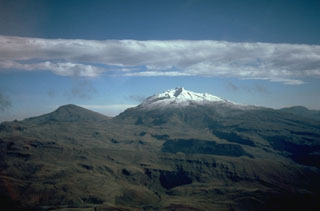Report on Chiles-Cerro Negro (Colombia-Ecuador) — 15 June-21 June 2022
Smithsonian Institution / US Geological Survey
Weekly Volcanic Activity Report, 15 June-21 June 2022
Managing Editor: Sally Sennert.
Please cite this report as:
Global Volcanism Program, 2022. Report on Chiles-Cerro Negro (Colombia-Ecuador) (Sennert, S, ed.). Weekly Volcanic Activity Report, 15 June-21 June 2022. Smithsonian Institution and US Geological Survey.
Chiles-Cerro Negro
Colombia-Ecuador
0.817°N, 77.938°W; summit elev. 4698 m
All times are local (unless otherwise noted)
Instituto Geofísico de la Escuela Politécnica Nacional (IGEPN) and the Observatorio Vulcanológico y Sismológico de Pasto del Servicio Geológico Colombiano (SGC OVSP) jointly monitor the Cerro Negro de Mayasquer and Chiles volcanoes, called the Chiles-Cerro Negro volcanic complex (CCNVC), and both issued reports on recent increased seismicity that began in May. Earthquakes were first felt on 12 June by residents near the border of Colombia and Ecuador, in the indigenous reservations of Chiles, Panán, and Mayasquer (Colombia), and in Tufiño (Ecuador). Seismicity continued, and from 0205 on 12 June to 0832 on 14 June there were 260 events clustered in two zones, in the S part of CCNVC (at depths of less than 6 km below the CCNVC summit) and about 9 km SE beneath Caldera de Potrerillos (at depths of 7-9 km). The earthquake swarm activity was similar to other swarms recorded since 2013.
A trend of inflation at a rate of approximately 28 mm/year has been recorded since 2016 (the beginning of deformation monitoring) through the end of 2020, when the deformation stabilized. Neither inflation nor deflation was detected during the beginning of 2020 or in 2021. Inflation was again detected in March and was continuing at a rate of 32 mm/year. Data from hydrothermal sites around CCNVC showed variations from previous measurements in gas data, and conductivity, temperature, pH, and morphology of a few of the hot spring locations, though they were a result of changes to the hydrothermal systems and not increased volcanic activity.
Geological Summary. The Chiles-Cerro Negro volcanic complex includes both the Pleistocene Chiles and the Cerro Negro de Mayasquer stratovolcanoes astride the Colombia-Ecuador border. Cerro Negro has a caldera open to the west, with andesitic and dacitic lava flows of possible Holocene age (Hall 1992, pers. comm.) and solfataras on the shore of a small crater lake. An eruption reported in 1936 may have been from Reventador (Catalog of Active Volcanoes of the World). The higher, glacier-covered summit of Chiles, about 4 km ESE of Cerro Negro, last erupted about 160,000 years ago, but it has a caldera open to the north with hot springs and an active hydrothermal system on its eastern flank.
Sources: Instituto Geofísico-Escuela Politécnica Nacional (IG-EPN), Servicio Geológico Colombiano (SGC)

